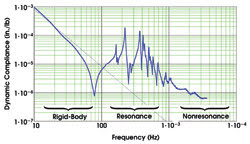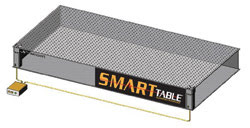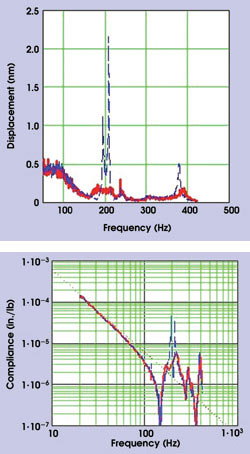The proper active damping technology enhances stability in manufacturing environments.
James Fisher and Vyacheslav M. Ryaboy, Newport Corp.
Optical tables, along with pneumatic vibration isolators, have numerous applications in research and high-precision manufacturing. In their basic form, optical tables consist of a sandwich structure: two faceplates and a lightweight honeycomb core. Their high stiffness-to-weight ratios are their main advantage.
Good isolation from floor vibrations in the 1- to 100-Hz range can be provided by most pneumatic isolated-support systems. However, ambient vibrations from 100 to 500 Hz generated by mechanical equipment — such as motorized stages — on or near the table surface cause the table itself to deform and deviate from the ideal rigid-body behavior at its resonant natural frequencies. These resonant vibrations cause misalignment of optical equipment installed on the table, which can reduce system performance and stability.
The performance of optical tables is generally characterized by their dynamic compliance, a ratio of dynamic deflection to input force, as a function of frequency. Compliance plots provide one way to estimate deviations from rigid body behavior (Figure 1). To reduce flexural vibration of the table, it is necessary to reduce the main resonance peaks, which are usually clustered between 100 and 500 Hz for the most common table sizes. The maximum amplification at resonance — generally known as Q — is a measure of the maximum deviation of the structure from the ideal rigid body line. The goal of any damping system is to reduce Q to its lowest possible level.

Figure 1. Compliance plots provide estimates of deviations from rigid-body behavior. This plot shows typical corner compliance of an optical table without any special means of damping.
Historical methods of reducing higher-frequency vibrations — such as structural and “wideband” damping by auxiliary mass coupled to the table by viscoelastic compounds — have limited effect. They also do not target the resonant frequencies that cause the most destructive interference in sensitive applications. Reducing these vibrations requires a more active damping system.
Active damping involves monitoring vibrations of a structure and using the vibration signal to generate force with the proper phase and amplitude to attenuate the vibration. An additional advantage of an active approach is the ability to monitor the vibration signal, which can be used to report or trigger other activities.
For example, Newport Corp.’s SmartTable and iQ damping system includes two sensor-actuator assemblies that are integrated into two corners of the optical table and connected to a central controller (Figure 2). This design ensures rigid coupling of the sensor and the actuator to both top and bottom face sheets.

Figure 2. Connecting a pair of sensor-actuator assemblies to a central controller ensures rigid coupling of sensor and actuator, and of damper to top and bottom face sheets.
The controller connected to the active dampers can communicate with PCs over a USB port and provide analog vibration signals for each sensor channel. Software allows users to change the controller settings and to collect, display and store vibration data in both time and frequency formats.
One of the unique features of this damping system is its ability to “autotune” to the specific load conditions of the application. This is accomplished by means of an algorithm in which each channel is tuned independently and then collectively to determine the optimal gain settings of the control loops, based on the stability domain of the system.
During this tuning process, the controller detects natural frequencies by analyzing system response to random vibrations generated by the internal actuators. The process is conducted automatically by the control firmware and is completed within seconds.

Figure 3. The linear spectra of vibration (top) and the dynamic compliance near the corner of the table (bottom) show the performance with active iQ damping enabled (dashed lines) and with the dampers disabled (solid lines).
The effect of autotuning is that the main resonance vibration peaks are decreased about tenfold after applying random excitation (approximately 0.25 lb rms) through a force sensor (Figure 3).
Meet the authors
James Fisher is director of product marketing and Vyacheslav M. Ryaboy is a senior staff engineer for Newport Corp. in Irvine, Calif. E-mail: [email protected] or [email protected].